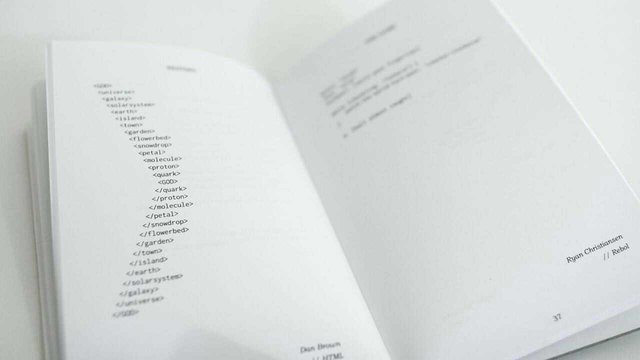PROGRAMMING IS POETRY
Programming is poetry
It’s a common misconception to think that programming and creativity are worlds apart. The assumption is grounded in a fundamental but incomplete truth: A computer program is an exacting set of instructions for a very dumb machine. This, or something like it, is the standard definition. There is no room for imprecision in software. No place for double-meanings or subtext.
But paths coders follow to develop these precise systems is not a direct one. No two programmers will ever produce identical code, not even if the final software appears from the outside to be the same. Give ten novelists a plot summary and they will each write you a different story. Give ten programmers a functional specification and each one will produce something unique, an expression of their own voice as a programmer.
The largest and smallest of scales collide and you are lost within it, completely absorbed by it. And it’s electric.
It helps if you forget about the purely functional definition of software as an end product. Instead, consider programming as a process.
An architect may ultimately produce blueprints, but to arrive at them she must consider space, harmony, light, materials, purpose, environment. The blueprints, as unflinchingly technical and mathematically precise as they may be, are the result of a deeply creative process. In the same fashion, programming is not really the practice of writing lines of code. It is the art of taking big, intractable problems and breaking them down into ever smaller ones which can be understood, explained and then carefully assembled into a living, breathing work of art.
Software is poetry. It’s the expression of ideas in the most elegant form a programmer can devise. Like a writer who chews the texture of words, rolls them against the tongue, seeks out the just-right way to tell each part of their tale, a programmer creatively employs structure and syntax of language to address problems, to arrange the sequence in which they are solved, assemble them into a story.
When you’re programming there are moments of sublime focus. At a practical level you’re writing a list of instructions, stepping line-by-line through the solution for a single current task amongst the thousands which collectively make up a computer program. The syntax rattles off the keyboard as easily and automatically as your lips and tongue shape words in conversation. But while these mundane mechanics are in play, there is something magical, something wonderful, taking place deeper in your brain.
You can see the system you’re building. You visualise the scope and scale of it. The relationship between each piece of data, the functions that process information, the flow of data as your code corrals it down this pathway here, assesses its value at that intersection over there, re-routes it for processing in a factory you’ve purpose-built. It’s not lines of code on a screen, it’s as real and physical as a sprawling city.
The thrill of this is hard to explain. It’s an act of creativity that ignites you. You’re holding dozens of threads simultaneously in your mind, like a writer simultaneously juggling the broad macroscopic concerns of plot lines, character arcs and pace with the minutiae of sentence structure, the rhythm of three syllables vs two, weighing the beat of a comma against the finality of a full stop. The largest and smallest of scales collide and you are lost within it, completely absorbed by it
Document source


wow... in our minds
Science and technology are improving and are subjected to change
Nice write-up
Nice write up darling